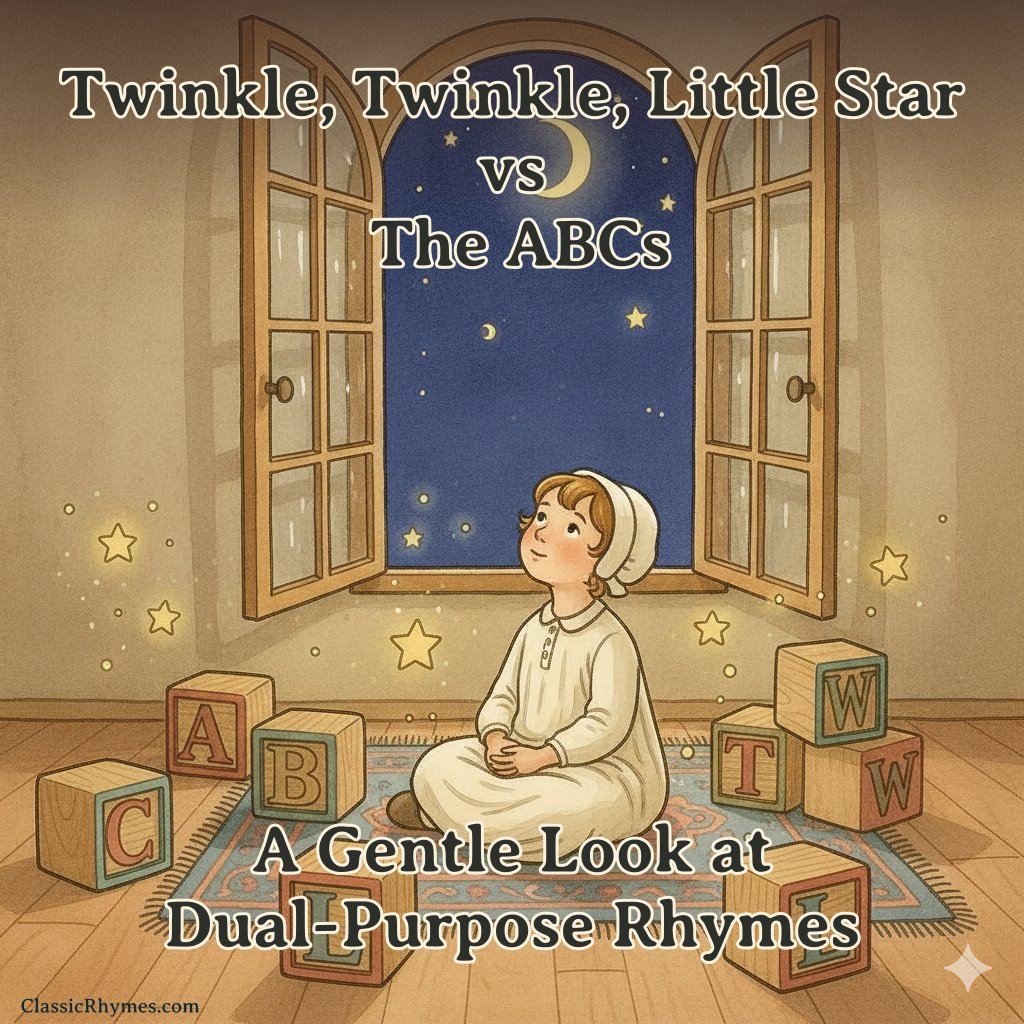Twinkle, Twinkle, Little Star vs. The ABCs: A Gentle Look at Dual-Purpose Rhymes
In the realm of classic rhymes, few melodies are as universally known as the one shared by “Twinkle, Twinkle, Little Star” and “The Alphabet Song”. These simple, soothing tunes are often among the first songs a child learns, yet their dual purpose is a testament to the incredible efficiency and adaptability of the nursery rhyme tradition. By analyzing how one tune can teach both celestial wonder and foundational literacy, we gain a deeper appreciation for the genius of these rhymes.
One Melody, Two Grand Lessons
Listen to piano melody:
The core of this dual-purpose magic lies in the music itself. The melody is derived from a 1761 French tune, “Ah! vous dirai-je, maman” (Oh! Shall I tell you, mama), which was later popularized by Wolfgang Amadeus Mozart’s twelve variations (K. 265/300e) on the theme. This simple, repetitive, and easily memorable structure is the perfect vehicle for early learning.

1. The Lesson of Wonder: “Twinkle, Twinkle, Little Star”
The familiar lyrics we know today were written by the English poet Jane Taylor in the early 19th century and first published in 1806. The rhyme, which uses a gentle question-and-answer format, does more than just soothe a child to sleep:
- Promotes Curiosity: It encourages children to look up and ponder the unknown. It’s an early introduction to astronomy and the vastness of the world beyond them.
- Introduces Concepts: Simple language is used to teach big ideas: high vs. low, light vs. dark, and motion (“through my window pane”).
- Emotional Connection: For centuries, it has served as a gentle lullaby, linking the rhythm of the language to feelings of comfort and security.
2. The Lesson of Literacy: “The Alphabet Song”
The adoption of the same melody for “The Alphabet Song” is a brilliant piece of practical pedagogy. Before the 1830s, the song’s tune varied, but once aligned with the famous Mozart variations, it became a standard educational tool.
- Rote Memorization Aid: The musicality of the rhyme dramatically assists rote memorization. Singing the letters connects a specific sound and rhythm to the visual shape of the letter, a foundational step in learning to read.
- Sequential Learning: It enforces the correct sequential order of the alphabet, which is crucial for dictionary use, filing, and other organizational skills later in life.
- Kinesthetic Learning: When children sing the song and simultaneously point to or trace the letters, they engage kinesthetic learning, reinforcing the lesson.
From Mozart to Muppets: The Rhyme in Pop Culture
The powerful simplicity of the “Ah! vous dirai-je, maman” melody has guaranteed its survival and adaptation across genres and generations. Its structural perfection allows it to be used not only for education but also for sophisticated art and playful parody.
Enduring Classical Influence
Long before it was a nursery staple, the tune was a foundation for serious composition. Mozart’s aforementioned variations were a start, but the melody has also appeared in works by later composers, including French composer Camille Saint-Saëns, who quoted it in the “Fossils” movement of his whimsical suite, The Carnival of the Animals. The continued use in classical music validates the tune as a work of structural brilliance, not just a simple nursery tune.
Parody and Modern Adaptations
When a piece of culture is universally known, it becomes prime material for reference and gentle parody.
- The Wonder of Space: The spirit of celestial curiosity in Twinkle, Twinkle, Little Star was humorously adapted in the 1960s when Leonard Nimoy (as Mr. Spock of Star Trek) recorded a version titled “Twinkle, Twinkle, Little Earth,” connecting the familiar lullaby to the final frontier.
- Literacy on Screen: The ABC Song is constantly reinvented, most famously by Sesame Street, which has collaborated with artists like Katy Perry and Stevie Wonder to keep the learning song fresh and engaging for every new television generation. This demonstrates the theme of Literacy as a continuous process, always requiring creative updates.
- Literary Play: Perhaps the most famous parody is from Lewis Carroll’s Alice’s Adventures in Wonderland, where the Mad Hatter performs his nonsensical version: “Twinkle, twinkle, little bat! How I wonder what you’re at!” This showcases how the rhyme’s familiar structure is a framework that readers instantly recognize and respond to, proving its deep cultural resonance.
The Power of Repetition and Simplicity
The success of these dual-purpose rhymes lies in their adherence to the best practices of early childhood education:
- Repetition: The consistent, predictable nature of the melody builds confidence in young learners. It’s safe, familiar, and creates a mental framework for new information.
- Cadence and Phrasing: The natural pauses and rhythms of the melody help children break down the alphabet into manageable chunks, especially the challenging sequence of L-M-N-O-P (often sung quickly as “elemenopee”).
- The Unifying Power of Music: For parents and teachers, the existence of two key educational tools set to one tune offers a simple, accessible way to transition between calming activity and structured learning.
In the end, whether a parent is singing “Twinkle, Twinkle, Little Star” to inspire a sense of wonder or “The ABC Song” to unlock the door to literacy, they are participating in a beautiful and effective tradition—a tradition whose roots reach back to a simple French tune that continues to educate and delight children across the globe.

